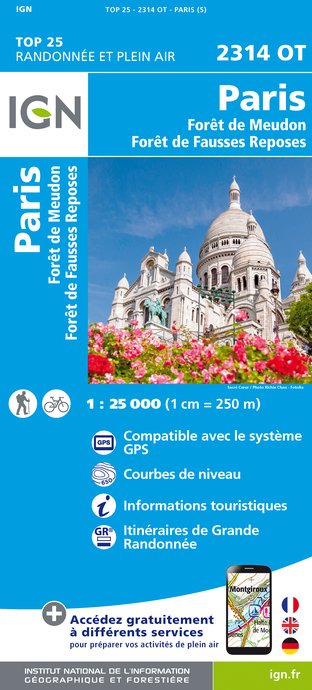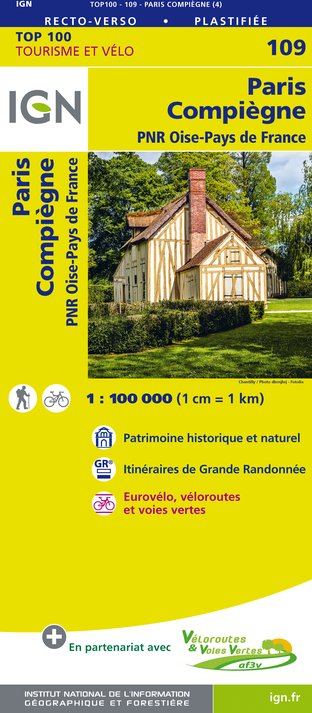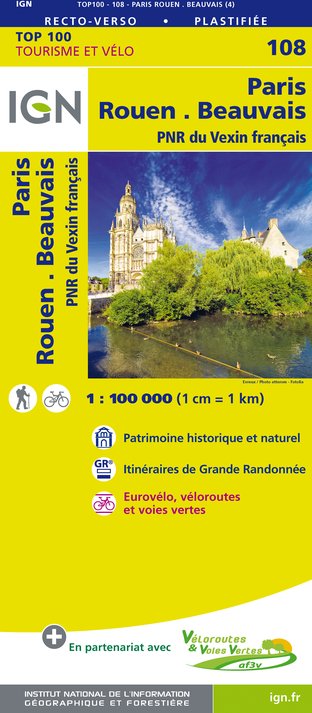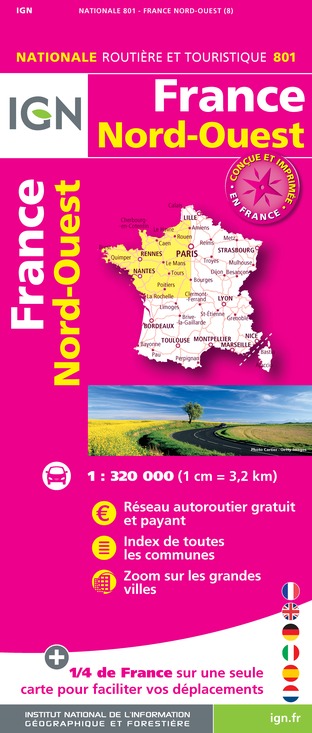警报
警报
练习类型
徒步
非常容易
2h
自行车
非常容易
1h
Presentation
地图
兴趣点
Cirkwi 简报
评级和评论
周围的看点
清新回归本源:巴黎的喷泉

信用 : Moonik via Wikipedia
Cirkwi 简报
探索巴黎:穿越其标志性喷泉的旅程
由Balades-Fluviales-An-Eala提出,这次旅程更多地是关于旅途本身,而不是到达目的地——通过巴黎迷人的水景,穿梭历史的漫步。想象一下自己在巴黎的街道上穿行,每一个转角都展现着过去时代的故事,伴随着潺潺流水的柔和声音。其目的不仅仅是展示每个喷泉的美学和历史魅力,更是让你沉浸在它们创造的氛围中——在繁忙的城市中营造出一片宁静和美丽的绿洲。让这些水景低语着它们的故事,从宏伟的奇迹到隐藏的宝藏,丰富你的步行体验,讲述巴黎的历史和文化的层次。
解读技术路线的见解
这个行程总共约6.8公里,被定位为一个相对容易的步行路线,适合所有健身水平的爱好者。从27米的海拔开始,最高处达到41米,往返的海拔差仅为23米,保证了整个行程的轻松节奏。有了这些说明,旅行者可以尽情享受风景和历史见解,而不会因为身体的紧张而受阻。因此,这种技术上的便利增加了旅游的可访问性,吸引了多样化的游客参与其中。
喷泉爱好者的季节提示
无论何时在巴黎进行喷泉之旅都是一个令人愉悦的体验,但每个季节都提供着独特的体验。在春天,见证周围的植物盛开,为历史喷泉提供了生动的背景。夏天虽然较热,但却把喷泉变成了凉爽的绿洲;然而,别忘了防晒霜和水!秋天笼罩着金色的光晕,非常适合摄影爱好者,而冬天尽管寒冷,却提供了较少的人潮和更宁静的旅程。无论季节如何,舒适的鞋子是必需的,并时刻准备巴黎天气的突变。
揭开历史的巴黎历史画卷
巴黎位于法国的Île-de-France地区,不仅是该国的首都,也是其历史和文化的核心。这座城市的喷泉长串象征着它复杂的历史,每一个都讲述着社会变革、建筑运动和城市发展的故事。从奥斯曼改革时期的巴黎整体改造,旨在应对公共卫生危机,到如今对这些水域财富的保护,这些喷泉的旅程反映了巴黎本身的动态演变。它们静默地见证着过去,目睹着这座城市不停地向前进。
巴黎游客的气候指南
巴黎傲视温和的海洋性气候,全年气温温和。春秋季节尤为宜人,成为探索户外奇观如历史喷泉的理想时机。冬季相对温和,但也可能有寒冷期,而夏季虽然较热,但一般保持着舒适的温度,对那些寻求水源消暑的人来说是一大福音。为了最大程度地享受体验,考虑在4月至6月或9月至11月之间访问,这段时间的天气最适合漫步探索巴黎的户外遗产。
由Balades-Fluviales-An-Eala提出,这次旅程更多地是关于旅途本身,而不是到达目的地——通过巴黎迷人的水景,穿梭历史的漫步。想象一下自己在巴黎的街道上穿行,每一个转角都展现着过去时代的故事,伴随着潺潺流水的柔和声音。其目的不仅仅是展示每个喷泉的美学和历史魅力,更是让你沉浸在它们创造的氛围中——在繁忙的城市中营造出一片宁静和美丽的绿洲。让这些水景低语着它们的故事,从宏伟的奇迹到隐藏的宝藏,丰富你的步行体验,讲述巴黎的历史和文化的层次。
解读技术路线的见解
这个行程总共约6.8公里,被定位为一个相对容易的步行路线,适合所有健身水平的爱好者。从27米的海拔开始,最高处达到41米,往返的海拔差仅为23米,保证了整个行程的轻松节奏。有了这些说明,旅行者可以尽情享受风景和历史见解,而不会因为身体的紧张而受阻。因此,这种技术上的便利增加了旅游的可访问性,吸引了多样化的游客参与其中。
喷泉爱好者的季节提示
无论何时在巴黎进行喷泉之旅都是一个令人愉悦的体验,但每个季节都提供着独特的体验。在春天,见证周围的植物盛开,为历史喷泉提供了生动的背景。夏天虽然较热,但却把喷泉变成了凉爽的绿洲;然而,别忘了防晒霜和水!秋天笼罩着金色的光晕,非常适合摄影爱好者,而冬天尽管寒冷,却提供了较少的人潮和更宁静的旅程。无论季节如何,舒适的鞋子是必需的,并时刻准备巴黎天气的突变。
揭开历史的巴黎历史画卷
巴黎位于法国的Île-de-France地区,不仅是该国的首都,也是其历史和文化的核心。这座城市的喷泉长串象征着它复杂的历史,每一个都讲述着社会变革、建筑运动和城市发展的故事。从奥斯曼改革时期的巴黎整体改造,旨在应对公共卫生危机,到如今对这些水域财富的保护,这些喷泉的旅程反映了巴黎本身的动态演变。它们静默地见证着过去,目睹着这座城市不停地向前进。
巴黎游客的气候指南
巴黎傲视温和的海洋性气候,全年气温温和。春秋季节尤为宜人,成为探索户外奇观如历史喷泉的理想时机。冬季相对温和,但也可能有寒冷期,而夏季虽然较热,但一般保持着舒适的温度,对那些寻求水源消暑的人来说是一大福音。为了最大程度地享受体验,考虑在4月至6月或9月至11月之间访问,这段时间的天气最适合漫步探索巴黎的户外遗产。
自动生成。
IGN 地图

2314OT - PARIS FORÊT DE MEUDON FORÊT DE FAUSSES REPOSES
编辑器 : IGN
收藏 : TOP 25 ET SÉRIE BLEUE
梯子 : 1:25 000
13.90€

119 PARIS SENS PNR DU GÂTINAIS FRANÇAIS
编辑器 : IGN
收藏 : TOP 100
梯子 : 1:100 000
8.40€

190 PARIS CHANTILLY FONTAINEBLEAU
编辑器 : IGN
收藏 : TOP 100
梯子 : 1:100 000
8.40€

118 PARIS CHARTRES PNR DE LA HAUTE VALLÉE DE CHEVREUSE
编辑器 : IGN
收藏 : TOP 100
梯子 : 1:100 000
8.40€

109 PARIS COMPIÈGNE PNR OISE-PAYS DE FRANCE
编辑器 : IGN
收藏 : TOP 100
梯子 : 1:100 000
8.40€

108 PARIS ROUEN BEAUVAIS PNR DU VEXIN FRANÇAIS
编辑器 : IGN
收藏 : TOP 100
梯子 : 1:100 000
8.40€

D75-95 ÎLE-DE-FRANCE OUEST
编辑器 : IGN
收藏 : CARTES DÉPARTEMENTALES IGN
梯子 : 1:150 000
5.90€

D77 SEINE-ET-MARNE
编辑器 : IGN
收藏 : CARTES DÉPARTEMENTALES IGN
梯子 : 1:150 000
5.90€

NR08 CENTRE-VAL DE LOIRE
编辑器 : IGN
收藏 : CARTES RÉGIONALES IGN
梯子 : 1:250 000
6.80€

NR03 ÍLE DE FRANCE
编辑器 : IGN
收藏 : CARTES RÉGIONALES IGN
梯子 : 1:250 000
6.80€

NR01 HAUTS-DE-FRANCE
编辑器 : IGN
收藏 : CARTES RÉGIONALES IGN
梯子 : 1:250 000
6.80€

801 FRANCE NORD OUEST
编辑器 : IGN
收藏 : CARTES NATIONALES IGN
梯子 : 1:320 000
6.10€

EUROPE
编辑器 : IGN
收藏 : DÉCOUVERTE DES PAYS DU MONDE IGN
梯子 : 1:2 500 000
7.00€
技术信息
徒步
难度
非常容易
持续时间
2h
(1天)
距离
6.8 km
练习类型
徒步
非常容易
2h
自行车
非常容易
1h
显示更多信息
高程剖面
起点
75006
Paris
Lat : 48.8534421Lng : 2.3437786
兴趣点
数据作者
评级和评论
周围的看点








